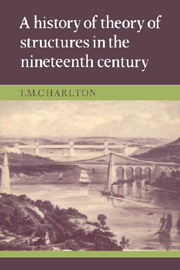Book contents
- Frontmatter
- Contents
- Preface
- 1 Introduction
- 2 Beam systems
- 3 Theory of the arch and suspension bridge
- 4 Elementary theory of frameworks: graphical statics
- 5 Theory of statically-indeterminate frameworks: the reciprocal theorem
- 6 Levy's theory of frameworks and bridge girders
- 7 Early developments of energy principles relating to theory of structures
- 8 The later development and use of energy principles
- 9 Applications of the least work principle: elastic theory of suspension bridges
- 10 Aspects of the further development of theory of structures
- 11 Secondary effects in structures
- Appendices
- Bibliography
- Name index
- Subject index
8 - The later development and use of energy principles
Published online by Cambridge University Press: 18 September 2009
- Frontmatter
- Contents
- Preface
- 1 Introduction
- 2 Beam systems
- 3 Theory of the arch and suspension bridge
- 4 Elementary theory of frameworks: graphical statics
- 5 Theory of statically-indeterminate frameworks: the reciprocal theorem
- 6 Levy's theory of frameworks and bridge girders
- 7 Early developments of energy principles relating to theory of structures
- 8 The later development and use of energy principles
- 9 Applications of the least work principle: elastic theory of suspension bridges
- 10 Aspects of the further development of theory of structures
- 11 Secondary effects in structures
- Appendices
- Bibliography
- Name index
- Subject index
Summary
Exploitation of the doctrine of energy, using energy functions and their derivatives in theory of structures, seems to have begun in earnest on the continent of Europe (by coincidence) soon after Cotterill's three important articles appeared in 1865. It was primarily due to the researches and principles of the Italian railway engineer Castigliano (1873, 1879), after Menabrea (1858). The implicit objective was to remedy deficiencies of statics by means of conditions of compatibility of elastic strain. Indeed, Castigliano's so-called principle of least work (terminology of Menabrea, 1884) was to become perhaps the best-known general method of structural analysis toward the end of the century. The contributions of Fränkel, Crotti and Engesser to the energy approach are, however, significant. But, in restrospect, Cotterill's priority over Castigliano and others seems unquestionable after careful study of his original articles. His obscurity, until comparatively recently, is undoubtedly due to the fashion in Britain to publish original work in both pure and applied science in journals devoted to natural philosophy, outstanding among which is the Philosophical Magazine in which Moseley and Maxwell, as well as Cotterill, published their contributions to theory of structures. Originally, like Moseley, a Cambridge mathematician of St John's College, Cotterill (who lived from 1836 until 1922) became professor of applied mathematics at the Royal Naval College.
- Type
- Chapter
- Information
- A History of the Theory of Structures in the Nineteenth Century , pp. 118 - 131Publisher: Cambridge University PressPrint publication year: 1982



